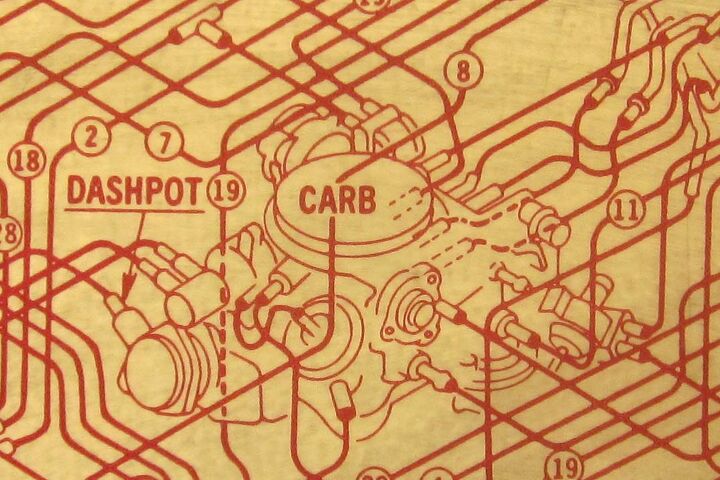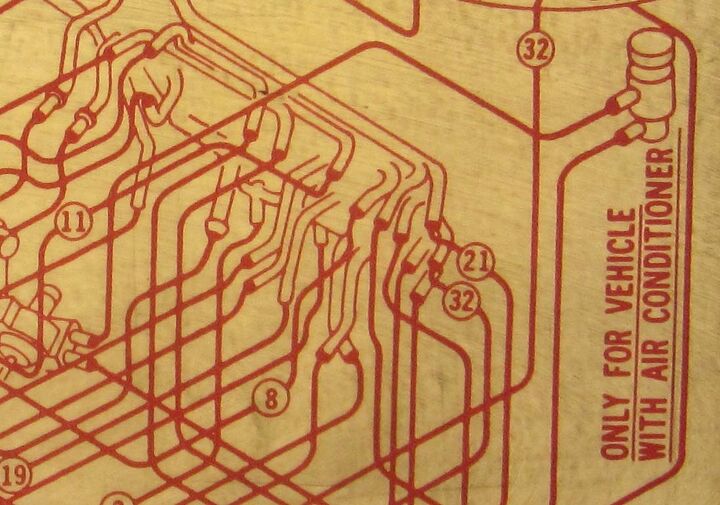Quick, Why Won't This Car Pass the Smog Check?

I’ve had more Honda Civics than any other type of car (at least one example of each of the first five Civic generations), at one point owning two ’85 hatches and a CRX at the same time. The mid-80s CVCC cars were great to drive and very reliable (provided you didn’t overheat the engine— ever), but when California tightened up smog-check requirements in the early 2000s it became impossible to keep one registered. Why? This.
If I ever decide to get a huge tattoo across my back, it will probably be this Vacuum Hose Routing Diagram for carbureted 1984-86 Civics. It’s as elegant as Harry Beck’s map of the London Tube system, yet terrifyingly complex to the backyard Civic mechanic who just wants to pass California’s dyno-based emissions test. Every time I spot one in the junkyard, I stop to check it out… and remind myself how happy I am with the bone-simple EFI plumbing under the hood of my ’92 Civic DX.
Why so ludicrously complicated? The CVCC stratified-charge system started out as a fairly simple setup: you had a big combustion chamber that got a lean air-fuel mix, a little combustion chamber that got a rich mix and the spark, and a two-in-one carburetor that supplied both chambers as needed. This worked great through the 1970s and into the 1980s, but as American— and Californian— emissions requirements got stricter, Honda had to add a bunch of auxiliary systems to ensure that the car wouldn’t spew out too much HC, CO, and/or NOx out the tailpipe, no matter what the driving conditions.
So, let’s say it’s 42 degrees out and your CRX has just hit the downhill grade on I-80 at Donner Pass. There’s a sensor to tell the car’s primitive ECU that external air temperature is below 60 degrees, another one that can tell you’re at high altitude, and yet another to detect that you’ve just backed off on the throttle. This information gets turned into vacuum signals, via a bunch of vacuum solenoids and valves, and then more vacuum signals are sent to various vacuum- or electro-vacuum-actuated devices, which adjust the fuel-delivery system accordingly. If any one of the hoses or devices in this system stops working, the car will probably run just fine… but it will almost certainly fail the tailpipe emissions test.
So (after hundreds of hours of testing and parts replacement— per car— in order to get my cars through the smog check), that’s why I got rid of my CVCC-ized third-gen Civics and swore to drive only fuel-injected versions from that point on.

Murilee Martin is the pen name of Phil Greden, a writer who has lived in Minnesota, California, Georgia and (now) Colorado. He has toiled at copywriting, technical writing, junkmail writing, fiction writing and now automotive writing. He has owned many terrible vehicles and some good ones. He spends a great deal of time in self-service junkyards. These days, he writes for publications including Autoweek, Autoblog, Hagerty, The Truth About Cars and Capital One.
More by Murilee Martin
Latest Car Reviews
Read moreLatest Product Reviews
Read moreRecent Comments
- Bob Funny how Oldsmobile was offering a GPS system to help if you were lost, yet GM as a company was very lost. Not really sure that they are not still lost. They make hideous looking trucks, Cadillac is a crappy Chevy pretending to be fancy. To be honest, I would never step in a GM show room now or ever. Boring, cheap ugly and bad resale why bother. I get enough of GM when i rent on trips from airports. I have to say, does anybody at GM ever drive what everyone else drives? Do they ever then look at what crap they put out in style fit and finish? Come on, for real, do they? Cadillac updated slogan should be " sub standard of the 3rd world", or " almost as good as Tata motors". Enough said.
- Sam Jacobs I want a sedan. When a buy a car or even rent one, I don’t want to ride up high. I don’t want a 5-door. I want a trunk to keep my stuff out of sight. It’s quieter, cars handle better, I don’t need to be at the same height as a truck. I have a 2022 Subaru Legacy Touring XT, best car ever, equipped as a luxury sedan, so quick and quiet. I don’t understand automakers’ decisions to take away sedans or simply stop updating them — giving up the competition. The Camry and Accord should not be our only choices. Impala and Fusion were beautiful when they were axed.
- Spamvw I think you need to remember WHY the big 2 and 1/2 got out of the car business. Without going political, the CAFE standards signed into law meant unless you had a higher gas mileage fleet, you couldn't meet the standards.The Irony is that, the law made sedans so small with low roof lines, that normal people migrated to SUV's and Trucks. Now we get worse mileage than before.
- TheEndlessEnigma Somehow, Toyota, Honda, Hyundai/Kia and Mazda are able to build sedans in North America AND turn a profit on those sedans at the same time.
- Tane94 There definitely is demand for sedans and history will condemn Ford, GM and Stellantis for abandoning the segment. Hyundai/Kia/Genesis and Honda, Toyota, Nissan continue to invest in their sedans and redesign the models.












































Comments
Join the conversation
I'd loved my '83 Civic S 1500 hatch... 160k flawless miles, 30 mpg easy. By today's standards it would be considered dog slow, but back then (and as 16 year old) it seemed very quick.
If CA is so bent on reducing smog, why do they insist on building all those huge housing tracts, freeways, and strip malls? Why do drivers insist on owning SUV's where it rarely snows? Why did they do away with the light rail in LA? Also, they can't blame Detroit for smog and sprawl, when Imports dominate there!